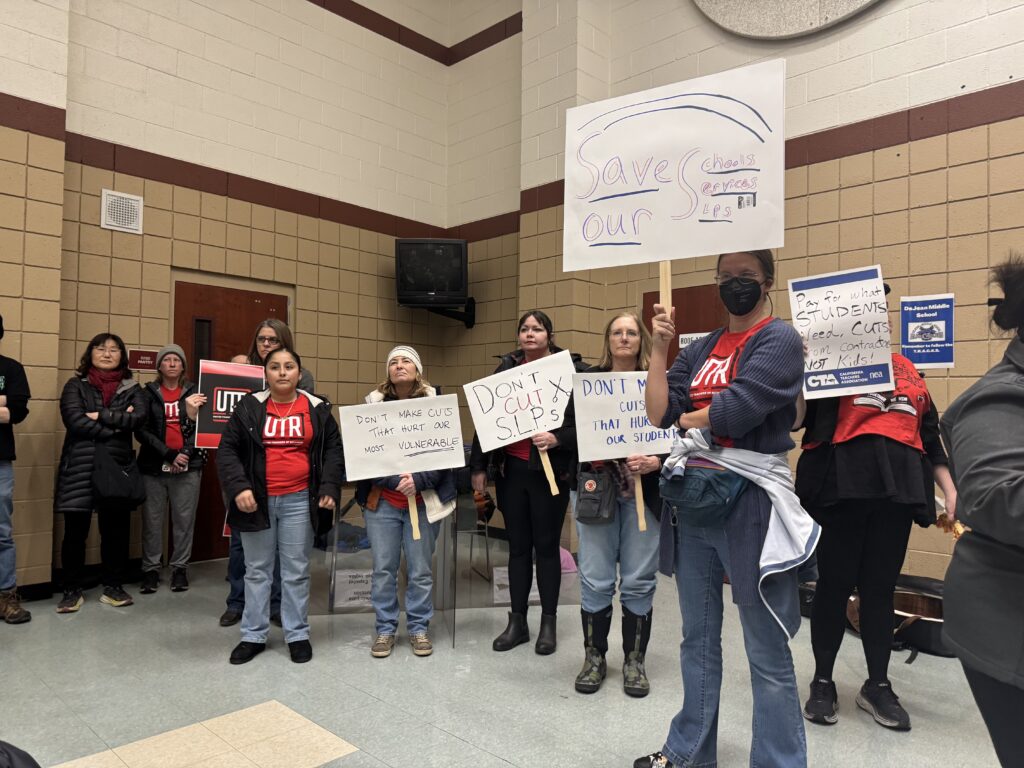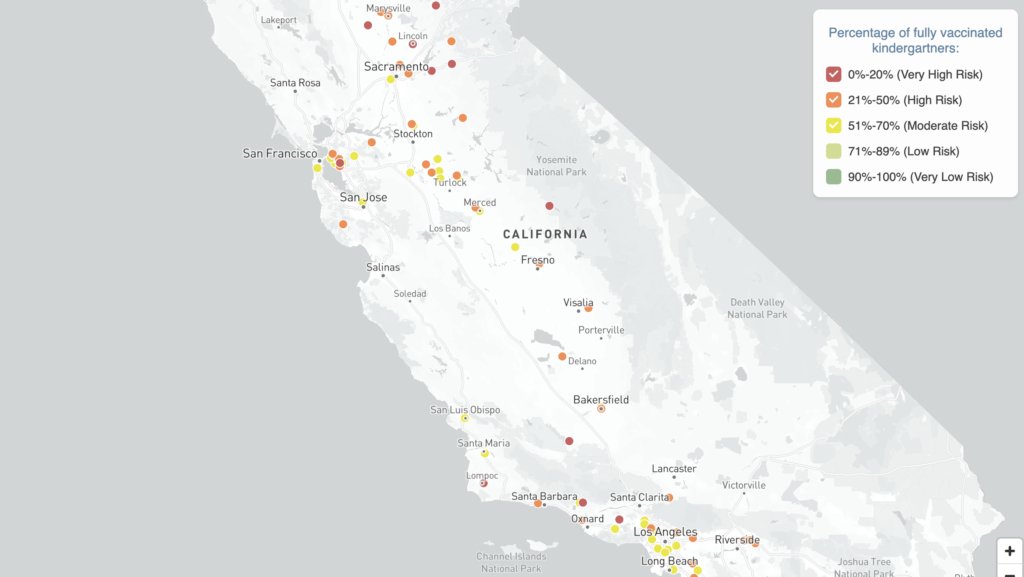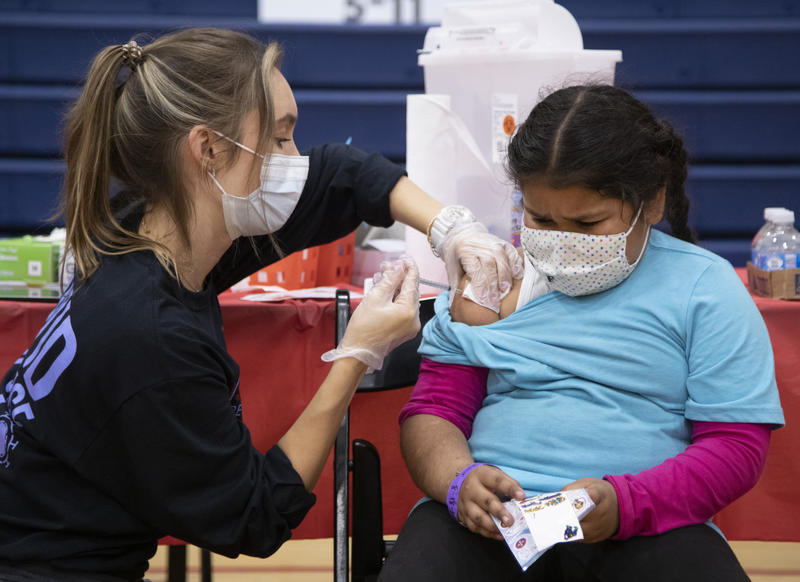
United Teachers of Richmond gather at West Contra Costa school board meeting Wednesday to protest staff cuts approved a week earlier.
Credit: Monica Velez / EdSource
In a move consistent with dozens of California school districts, West Contra Costa Unified board members have had to choose between eliminating staff and services for students or exploding its budget deficit.
At the start of the debate at Wednesday night’s school board meeting, the district had proposed cutting about 177 staffing positions and, after nearly three hours of debate, the board voted 3-1 to cut all but eight. But saving those eight positions jeopardizes funding for services for at-risk students.
“Ultimately, with these decisions, our students will suffer the most without the staff that is needed to provide them with an excellent education that they deserve and which is necessary to decrease the longstanding education gaps for the district’s Black and brown students,” said Sheryl Lane, executive director of Fierce Advocates, a Richmond organization focused on working with parents of color.
Out of the positions that are being eliminated, 122 are already vacant, according to district officials. And so far, the district has also received 27 resignations and 47 retirement notices.
It’s unclear if there will be layoffs, but on Feb. 6, interim Superintendent Kim Moses said that because of vacancy levels, the district administrators “expect that there will be a certificated job available for all current WCCUSD (West Contra Costa Unified School District) educators for the 2025-26 school year.”
Throughout this month, educators, parents, students and community members showed up in large numbers to speak, as they have in all board meetings since the budget talks started, urging the board to reconsider cutting staff positions.
“We saw today the dysfunction,” United Teachers of Richmond President Francisco Ortiz said during the meeting. “We need collaboration. Every single cabinet member has my direct phone number. Every board member has my phone number. We have been excluded from the decision-making process and in the collaboration since the new administration took over. This situation has been imposed on us, but we’re ready to fight.”
A split board
It took nine amended resolutions for a vote to pass on Wednesday night. Trustee Demetrio Gonzalez-Hoy attempted to save high school teachers, school counselors, social workers, psychologists, speech therapists, and career technical education educators.
But the board was split.
Board President Leslie Reckler and trustee Guadalupe Enllana voted down the motions while Gonzalez-Hoy and trustee Cinthia Hernandez were determined to save some staffing positions.
The successful resolution saved one part-time psychologist position, one part-time and seven full-time high school teachers. Reckler voted down the resolution and trustee Jamela Smith-Folds was absent.
In an email to EdSource, Reckler argued the board had already approved the fiscal solvency plan and if the cuts weren’t passed, “it shows the board to be an unreliable steward of public funds, and I will not be lumped into that category.”
“My prime responsibility is to ensure the long-term fiscal solvency of the school district and ensure continued local control in decision-making,” Reckler said. “Last night’s vote will make it more difficult for the school district.”
The top priority for Gonzalez-Hoy was to save the high school teacher positions because cutting them would have caused some schools to go from a seven-period day to six, he said. English learners, students with disabilities and students who need more academic support would be most affected because they often need to take on extra courses and benefit from having more class periods.
“I could not in good conscience make those reductions, knowing the unintended impact they would have,” he said. “Even though it was a very difficult conversation and decision, I did vote to cut the majority of the positions, in part due to our ability to possibly retain some of those positions through grants, but also due to our financial situation.”
In an emailed statement, Enllana said the board and district can no longer continue to be “driven by individual interests but must prioritize the needs of all students.”
“There is a clear distinction between needs and wants. Our first responsibility is to secure what our students need, and then work towards fulfilling the wants under our current budget.”
California schools are in a budget crisis
This week, other Bay Area school boards also made the difficult decision to lay off employees for the coming school year. Oakland’s school board voted to cut 100 positions, the San Francisco Chronicle reported. According to KQED, San Francisco Unified will also send pink slips to more than 500 employees.
West Contra Costa Unified has to balance between the need for fiscal solvency and keeping the schools adequately staffed with teachers, social workers, psychologists and other support staff.
“These decisions by the school board are tough ones and speak to the structural changes needed at the state level to change the revenue it receives that can go towards funding local school districts, like WCCUSD,” Lane said.
The district has been under financial stress since last year and could risk insolvency if its fiscal plan isn’t followed.
When districts can’t get out of deficits, they risk being taken over by the state and losing local control over budget decisions. Twenty-six years ago, West Contra Costa became the first district in the state to go insolvent and received a $29 million bailout loan, which took 21 years to pay off.
To stay out of a deficit, West Contra Costa has to cut $32.7 million in costs between 2024 and 2027. District officials have said about 84% of the budget is used to pay salaries and benefits — the reason staffing cuts would be unavoidable.
The district needs to put forth a fiscal solvency plan approved by the Contra Costa County Office of Education to avoid going insolvent and risking a takeover, Moses said. The staffing cuts are tied to the plan and must happen for the district to stay on track. The board approved the plan earlier this month.
“It would be multiple millions of dollars of impact to the general fund if we don’t take action,” Moses said during the meeting. “The response to the county, if that is the case, I think we would be sending a strong message that we are not addressing our fiscal stability, and that would not be advisable as they are oversight agents.”
The price of compromise
Saving the high school teacher and psychologist positions will add $1.5 million to $1.75 million to the deficit, Moses said. The district doesn’t have a choice but to use funds that are meant for student services and will likely have to dip into the $4 million set aside for math curriculum.
“We value all staff and their dedication to our community; however, the fiscal health of our district has to be prioritized as the foundation for our ability to continue normal district operations,” Moses said in a news release Thursday. “I am concerned about the added fiscal uncertainty we face after last night’s board meeting.”
Cutting the money for teacher and math support is a step backward for the district, which makes it more difficult for educators to help students improve, said Natalie Walchuk, vice president of local impact at GO Public Schools, an organization advocating for equitable public education. In West Contra Costa, only 1 in 4 students are performing at grade level in math and just 6.1% of seniors are ready for college-level math.
“Teachers need the right tools and resources to support their students, yet the district has lagged for years in adopting a new math curriculum,” Walchuk said. “While we recognize the difficult financial decisions the board had to make, it is critical that the district prioritizes student learning.”
The positions on the chopping block came from two pots of money — the general fund, which accounts for 40 positions, and grants, which cover 137 positions. Money for grant-funded positions is either expiring or has been used faster than projected, said Camille Johnson, associate superintendent of human resources.
Trying to save the grant-funded positions would add to the deficit, Moses said. Although the district staff is working to secure more grants, the funds districts receive from the federal government are uncertain.
“We were not in a position to consult the (teachers) union because we do not have money to pay for these positions,” Moses said during the meeting. “Negotiations in terms of what stays and what goes was not possible in this scenario because it’s strictly driven by money that is expiring or money we aren’t responsible for assigning.”
The district doesn’t have a choice but to eliminate some positions because they are dependent on school sites approving the positions in their budgets, Moses said. If approved, about 78 positions could be reinstated.
The deadline to give layoff notices is March 15.

















